Setting the scene is one of the most important elements of storytelling.
It helps the reader picture not just the scene, but the situation, emotions, and thoughts that go on during that scene. You want to make sure the reader feels as though they’ve entered a portal into a different universe. You want them to not just be stimulated, but at the mercy of the world you’ve created around them.
I’ll have more on this later, but here are some bite-sized tips to help you become a master scene setter.
Start with a crazy quote—I do this all of the time when I tell a story at the beginning of an article. I put a crazy quote that I or someone else said in the story, and use that as the opener to hook the reader. It helps me get the concept of the story down so I can set the scene more accurately. For example, here’s a real quote from one of my stories: “I’m going to beat your a*s when I see you.” Someone really said that to me. So I used that at the very beginning of my article. Then, I explained all of my thoughts, emotions, and the context of what happened from there.
Include thoughts & emotions—Most people dumb down scene setting to sensory details. While those are important, you also want the reader to FEEL what you convey to them, not just what they’re supposed to smell. Most people can imagine what a gym could smell like. They won’t know the severity of mentally exhausting it could be to lift 200-pound weights and do an hour of cardio for two hours a day. Thoughts and emotions matter more than sensory details for the advanced scene setters.
Practice short sentences—I used to struggle with this a ton with scene setting. I would write the longest descriptions possible because I thought the more you wrote, the more you set the scene—FALSE. This is where you want to do more with less. You don’t want to get to the point where you bore the reader. Setting the scene shouldn’t be longer than a paragraph or two. Don’t stretch it. Practicing short sentences helped me get better at saying more with less and using more active voice to set the scene. Force yourself to write as many short sentences as possible and watch your scene setting improve automatically.
I hope this helps.
Now, go outside and set the scene.





Khadejah, this post hit me right where I needed it.
Scene setting has always been one of those things I think I am doing well—until I re-read my draft and realize I have just described a park bench and the weather, and completely missed the emotional storm inside my character’s head. Your line about including thoughts and emotions really opened my eyes. You are right—most people can guess what a gym smells like, but they "cannot" feel the inner grind unless I let them into the mental chaos of pushing through it.
And that opening quote tip? 🔥
“I’m going to beat your a*s when I see you.”
I "felt" that. It is raw, it is real, and it immediately makes me lean in, needing to know the story behind it. That kind of opening is not just a hook—it is a doorway.
Also—short sentences. YES. I used to equate long, lyrical descriptions with literary merit, but they just ended up clogging the story. I have been challenging myself lately to write tighter, punchier prose, and it is refreshing to hear you confirm that is the way to go.
Thank you for making this so practical and so real. Your voice in this piece? Feels like a mentor walking beside me, not preaching from a podium.
Going outside now … to set the damn scene. 😉
I am enjoying this story series. Thanks for sharing.